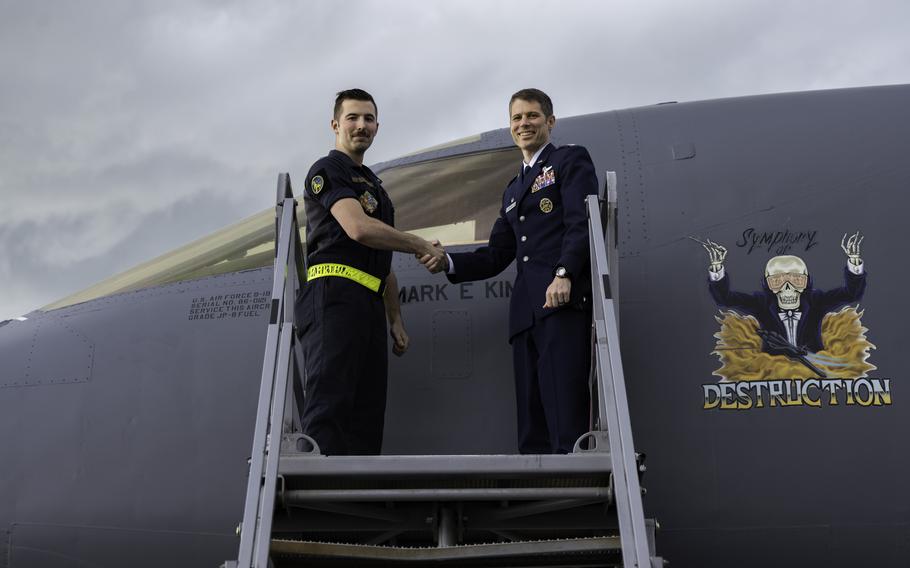
The B-1 bomber crash site at Ellsworth Air Force Base in South Dakota. The $450 million plane was attempting to land in low-visibility conditions when the four crew members were forced to eject before the plane skidded about 5,000 feet across the runway and caught fire. (U.S. Air Force)
The commander of an operations group at Ellsworth Air Force Base was fired after an investigation found multiple crew failures led to a supersonic bomber’s crash landing in January, the service announced.
Col. Mark Kimball was relieved as commander of the 28th Operations Group at the South Dakota base due to a loss of trust and confidence in his ability to command. The decision was based on the findings of an Accident Investigation Board report into the Jan. 4 crash of a B-1B bomber at the base, the Air Force Global Strike Command said in a statement issued Friday.
The report, released July 25, found the fiery crash, which happened as the aircraft landed following a training exercise, was primarily caused by multiple crew failures, as well as winter weather, that resulted in all four members ejecting and the total loss of the $450 million warplane. The crash exposed an “organizational culture that tolerated decaying airmanship skills, a lack of discipline, poor communication and inadequate focus on regulations,” the report read.
The Air Force said in the report that the service will use the report to take administrative and disciplinary action. The Global Strike Command did not say whether any actions were handed out to members in the 28th Operations Group, aside from Kimball, instead deferring to the 28th Bomb Wing at Ellsworth. The operations group falls under the leadership of the bomb wing.
Col. Derek C. Oakley, commander of 28th Bomb Wing, has taken command of the operations group. A replacement for Kimball has not yet been announced.

Air Force Col. Mark Kimball, pictured on the right, takes command of the 28th Operations Group on June 9, 2023, at Ellsworth Air Force Base, S.D. Kimball is shaking the hand of Staff Sgt. Jacob Szatkowski, the 28th Aircraft Maintenance Squadron dedicated crew chief. (Josephine Pepin/U.S. Air Force)
Kimball was commissioned in 2002. He served as a B-1B instructor pilot on four prior assignments. He served as deputy commander of the 28th Operations Group before assuming the role of commander of the unit in June 2023.
The operations group supports combat operations and develops deployment plans for the B-1 bomber. The aircraft carries conventional weapons and can take off from the U.S. to strike targets overseas in a single mission.
The plane was attempting to land in low-visibility conditions when the four crew members were forced to eject before the plane skidded about 5,000 feet across the runway and caught fire. The crew failed to properly manage the aircraft’s airspeed and angle of approach — coming in too slow and too low for the weather conditions, according to the report.
“Changes in local wind direction during landing should have prompted the crew to adjust throttles and maintain proper airspeed, but a lack of situational awareness and ineffective crew communication resulted in the aircraft falling below required airspeed to maintain a safe approach,” the report read.
The board also identified several other “substantial contributing factors,” including poor crew resource management, poor weather conditions, ineffective flight operations supervision and a lack of awareness of airfield conditions.
Neither the pilot nor a supervisory instructor pilot realized the plane was losing too much power because they were looking outside the aircraft instead of monitoring their instruments, the report concluded.
Another crew member responsible for assisting with cross-checking testified they were reading a post-landing checklist instead of backstopping the instruments, the investigators found.
The lack of communication and supervision permeated beyond the cockpit.
A pre-flight squadron brief did not advise the crews of two bombers to approach at a higher altitude, given the lost visibility, and investigators found none of the eight aviators aboard the aircraft knew the Air Force’s instructions for the cold weather in which they were flying.
Additionally, there was a “willful disregard” for the equipment each crew member was required to wear, which the report said could have contributed to the injuries that they received from ejecting.
Three of the crew members suffered minor injuries and were treated at the base. The instructor pilot was hospitalized for significant injuries and temporary loss of consciousness.
The instructor pilot weighed at least the maximum of 245 pounds that the ejection seat could support, which the investigation found could have contributed to his injuries. A few days after the crash, he weighed 260 pounds, the report found.
On the airfield, a key sensor on the runway that could have told the crews about the bad visibility had been malfunctioning for months. Air traffic control knew the sensor was broken, but the squadron did not.
The control tower also knew on-the-ground visibility was zero but did not communicate that to anyone. The first bomber was also criticized by investigators for failing to relay that information to the second bomber, the report found.
Additionally, after the crash, two members of the maintenance crew failed toxicology tests.
The investigation ultimately found the bomber crashed because the crew “succumbed to complacency and fixation, while the [instructor pilot] was ineffective in his crew leadership and instructor supervision duties,” according to the report.